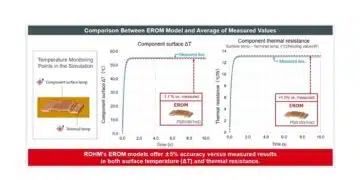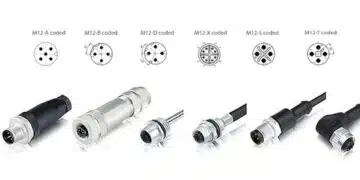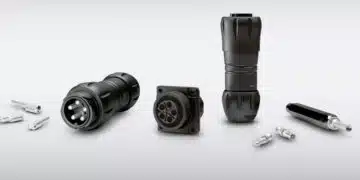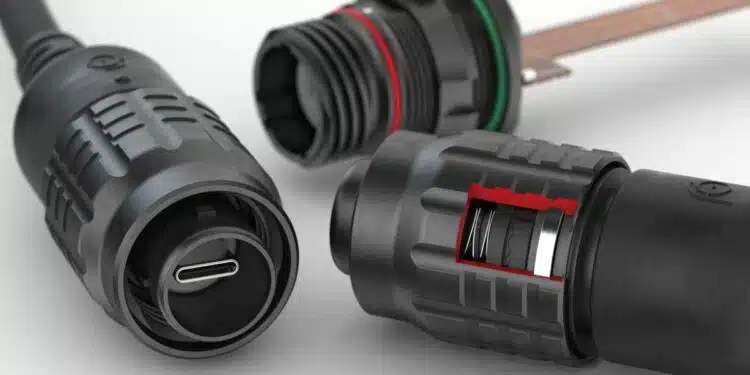Fischer Connectors has brought its world-renowned Swiss engineering expertise to the universal USB-C standard. Its Ratchet Locking USB-C Connector System provides unmatched resistance to vibration and shock.
The Fischer UltiMate™ Series, the company’s flagship range for harsh environments, now includes a pre-cabled USB-C connector equipped with Fischer Connectors’ new Ratchet Locking System (RLS).
This connector provides unmatched resistance to vibration and shock, ensuring safe connections for high-speed data transfer under extreme operating conditions in sectors such as defense, mining, construction, motorsports and railways.
Leveraging its core competencies in ruggedization, sealing, miniaturization, and data transmission, Fischer Connectors designed the connector to provide optimal reliability in mission-critical environments, ensuring safe and stable connections in demanding applications and markets, such as defense armored vehicles, UAVs, and UGVs, mining, heavy machinery at construction sites, motorsports, and railways. These environments are characterized by high levels of vibration and shock.
Ratchet Locking System (RLS) designed to resist high vibration and shock
At the heart of this innovation is the new Ratchet Locking System (RLS). Its fastening mechanism uses an asymmetrical tooth profile to securely lock under load and resist loosening under high vibration. Key benefits include exceptional vibration resistance (by maintaining lock under high-frequency vibration), tool-free operation (easy mating and unmating in the field, even with gloves), and durability with high rates of mating cycles.
Logically, Fischer Connectors has introduced the RLS to its most robust product line, UltiMate. In the Fischer UltiMate’s classical size 15 contact block (with up to 27 pins and 25.8-mm receptacle diameter), the RLS system achieves the best vibration and shock resistance in the entire Fischer Connectors product portfolio, withstanding 37.8 Grms of random vibration and 300 g of shock amplitude.
Ruggedized USB-C connector for harsh environments
The new UltiMate USB-C connector with RLS has been independently validated to withstand 5.35 Grms of random vibration (50–2000 Hz, 3×1.5 hrs, no discontinuity >1 μs), 10 g of sinus vibration (10–500 Hz, 3×3 hrs, no discontinuity >1 μs), and shock up to 100 g (half sine pulse, 6 ms, no discontinuity >1 μs).
Additional features include an IP68 sealing for the plug; hermeticity for the receptacle (<10⁻⁸ mbar l/s); an operating temperature range of -30 °C to +80 °C; corrosion resistance of 350 hours of salt mist; 3,000 mating cycles; and 360° EMC shielding.
“Our new USB-C RLS connector offers environmental and mechanical performance in compliance with IEC and MIL-STD norms,” says Alexandra Monchâtre, Head of Product Management at Fischer Connectors. “This new product truly offers the best of both worlds: the ultra-standard and the ultra-rugged.”
As part of a versatile portfolio of rugged, compact and high-speed connectors
With its new USB-C interface supporting high-speed data, video, and power transmission over a compact connector footprint, the new Fischer UltiMate USB-C RLS connector complements Fischer Connectors’ existing range of rugged, high-speed data transmission solutions designed for signal integrity, mechanical endurance, and space-constrained environments.
The UltiMate USB-C RLS is available as a pre-cabled plug and receptacle (28 mm diameter) with a flex PCB. This all-in-one solution provides robust connectivity and flexibility in various design configurations for modern electronic devices, especially in applications where space, speed, and reliability are critical. It offers a compact design and supports USB 3.2 Gen 1×2 transmission with data rates up to 10 Gbit/s.
The new USB-C RLS connector expands Fischer Connectors’ offerings across its high-speed Core, MiniMax, and UltiMate series, which support data protocols such as USB 3.2, Ethernet up to 10 Gbit/s, Audio/UHD Video up to 18 Gbit/s (HDMI 2.0 type), and Single Pair Ethernet (SPE).
“As part of our technology and innovation strategy, our Group R&D team offers engineers designing applications in extreme environments a versatile technology platform with various standards and connector types,” explains Alvaro Goncalves, Technology Director at the Conextivity Group, of which Fischer Connectors is a part. “This new USB-C connector with RLS is a good example of how we combine our technology ‘bricks’ – high-density miniaturization, high-speed data, and ruggedness – to increase integration capability, compatibility, and interoperability across customer markets. Conextivity has the innovation, agility, and precision skills needed to meet the most stringent requirements in demanding environments.”
































